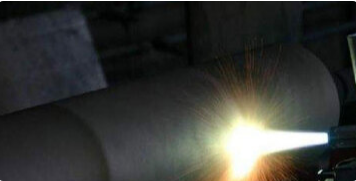

On the basis of plasma spraying, several new plasma spraying technologies have been developed, such as:
1. Vacuum plasma spraying (also called low pressure plasma spraying)
Vacuum plasma spraying is a technology of spraying in a sealed chamber with a controllable atmosphere and 4-40Kpa.

Because the working gas is plasmonized, it is ejected while expanding its volume in a low-pressure atmosphere, so the jet velocity is supersonic, and it is very suitable for materials that are highly sensitive to oxidation.
2. Water stable plasma spraying
The working medium of plasma spraying mentioned above is all gas, and the working medium of this method is not gas but water. It is a high-power or high-speed plasma spraying method. Its working principle is:
A high-pressure water flow is passed into the spray gun, and a vortex is formed on the inner wall of the gun barrel. At this time, a DC arc is generated between the cathode at the rear of the gun body and the rotating anode at the front of the gun body, so that a part of the inner wall surface of the gun barrel is evaporated, decomposed, and changed. into a plasma state, producing a continuous plasma arc. Due to the bunching effect of the swirling eddy water, its energy density is increased and the combustion is stable. Therefore, high melting point materials, especially oxide ceramics, can be sprayed, and the spraying efficiency is very high.
3. Gas stable plasma spraying
The principle of gas-stabilized plasma spraying is to generate a plasma jet (arc flame) from a plasma spray gun (plasma arc generator). The electrode (cathode) and nozzle (anode) of the spray gun are respectively connected to the positive and negative electrodes of the rectifier power supply, and the working gas (Ar, N2, etc.) is supplied to the spray gun, and the arc is ignited by high-frequency sparks. The arc heats the gas to a very high temperature to ionize the gas. Under the action of thermal shrinkage, self-magnetic shrinkage and mechanical effects, the arc is compressed to produce a non-transferable plasma arc. After the high-temperature plasma gas is ejected from the nozzle, the volume expands rapidly to form a high-temperature high-speed plasma jet. After the feeding airflow pushes the powder into the plasma jet, it is rapidly heated to a molten or semi-molten state, and the plasma jet is accelerated to form a sprayed ion beam of the flying substrate, which successively hits the surface of the pretreated substrate to form a coating. Atmospheric plasma spraying uses argon, nitrogen and hydrogen as the plasma gas.
Hot information

